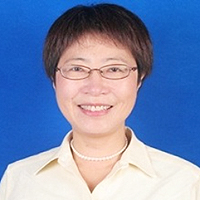Au26-35: A Special Geometrical Structure of Au33 (D2) Cluster with Highly Occupied - 14 Pairs of Double-State Degeneracy
Published on: 30th December, 2022
In this article, an interesting phenomenon has described the geometries and vibrational frequency of the stable AuN clusters with N = 26 to 35. We have found nine out of ten clusters are having the very same C1 symmetry, except the cluster N = 33 (D2). The finite-differentiation method has been implemented within the density-functional tight-binding (DFTB) approach. The effects of the range of interatomic forces were calculated and the desired set of system eigenfrequencies (3N-6) are obtained by diagonalization of the symmetric positive semidefinite Hessian matrix. Mainly, we have observed the vibrational spectra and the range comes in between 2.04 and 347.32 cm−1 at ground state, ∆E = 0. Most significantly, all the clusters have revealed double-state degeneracy. The vibrational spectrum is strongly dependent upon the size, shape, and structure, at the same time, the stretching and the bending mode of the atoms with respect to the bond length plays a major role. We have compared some of our results, which have an excellent agreement, with the less availability of the experimental and the theoretical predictions.
Bipolar and Goldenhar: A Case Report of Bipolar Disorder with Psychotic Features in a Man with Goldenhar Syndrome
Published on: 24th August, 2023
Background: Goldenhar syndrome is a congenital condition primarily affecting eye, ear, and spine development. In some cases, it can also impact the heart, lungs, kidneys, and central nervous system. The exact cause of Goldenhar syndrome is not fully understood, and its incidence is estimated to range from 1 in 3500 to 1 in 5600 live births. While intellectual disability is associated with the condition, no established link exists between Goldenhar syndrome and psychiatric disorders.Case presentation: In the presented case, a patient with Goldenhar syndrome has been diagnosed with an episode of mania with psychotic features in the context of bipolar disorder. The patient had no history of prior mental disorders and had an independent life.Discussion: There are few case reports of Goldenhar syndrome patients with mental disorders. In all instances, including our own case, patients exhibited psychotic features during psychiatric examinations.Conclusion: Based on the studies cited and our own research, it is recommended to further investigate the potential association between this syndrome and psychiatric disorders.The following sections provide details on the examination, medical history, and treatment of this patient.
Bleeding from Varices: Still a Heavy Burden in Patients with Cirrhosis
Published on: 27th December, 2023
Introduction: Bleeding from varices is a severe complication in patients with cirrhosis. Despite its treatment has been well established in the last three decades the mortality can be still high. This study compares the epidemiological features and the bleeding-related outcomes of a group of patients published about ten years ago with a more recent group of 168 consecutive patients. Methods: The diagnosis, the treatment, and the main outcomes (5-day failure, 5-day and 6-week rebleeding, 5-day and 6-week mortality) of variceal bleeding were evaluated according to the current guidelines.Results: The number of patients with cirrhosis admitted for variceal bleeding every year has progressively decreased in the last ten years. The age sex and severity of liver disease, evaluated with Child Pugh and MELD scores, were comparable in the two series. In the more recent series, there were significantly fewer patients with HCV infection and more patients with alcohol-related cirrhosis. The main outcomes of bleeding were comparable too. Overall, at 6 weeks 36.4% of patients did not overcome the bleeding episode. Conclusion: The decreasing incidence of bleeding from varices is likely attributable to antiviral treatment of HCV and HBV and the larger diffusion of beta-blockers in primary prophylaxis. Despite the larger application of the gold standard therapy, the mortality of variceal bleeding remains high in patients with cirrhosis.
Superior Gluteal Artery Pseudoaneurysm following a Periacetabular Osteotomy
Published on: 1st March, 2024
Periacetabular Osteotomy (PAO) is the gold standard for the treatment of hip dysplasia or acetabular retroversion. Due to the proximity of intra-pelvic arteries, there is a risk of iatrogenic vascular injuries, which can present with a delay and should be part of the differential diagnosis of significant pain following a PAO. We present the case of a never-described vascular injury following a periacetabular osteotomy in a 25-year-old woman who presented with gluteal pain 3 weeks after surgery. A delayed diagnosis of a pseudoaneurysm of the superior gluteal artery was made and successfully treated by embolization. The lesion is most probably related to the tip of a screw or to the drilling process.
A Low-cost High-throughput Targeted Sequencing for the Accurate Detection of Respiratory Tract Pathogen
Published on: 12th March, 2024
Introduction: The current gold standard for SARS-CoV-2 diagnosis by real-time RT-PCR has limitations of gene numbers that can be detected. In this study, we developed a low-cost and high-throughput next-generation sequencing technology that can overcome the limitations of RT-PCR. Methodology: A targeted sequencing panel (TSP) consisting of approximately 500 amplicons was designed that can simultaneously detect a broad range of gene loci of SARS-CoV-2 and genes for the most common viruses of respiratory infectious viruses in a single run of up to 96 samples. 448 samples and 31 control samples were examined independently with both TSP and RT-PCR, results were compared for accuracy and other indicators. Results: TSP identified 50 SARS-CoV-2 positive samples with a 99.33% match to RT-PCR results. It is not surprising that TSP also identified multiple viral infections from 96 samples, whereas RT-PCR could not. TSP demonstrated its ability to conclude diagnosis for those undecided from RT-PCR tests. Conclusion: Our data demonstrated that TSP is a fast and accurate test for detecting multiple pathogen infections of the respiratory tract.
Endoscopic Endonasal total Removal of a Suprasellar, Preinfundibular Retro Chiasmatic Craniopharyngioma: A Surgical Case Report
Published on: 26th March, 2024
Craniopharyngiomas are benign tumors (WHO Grade I), seen in children and adults. Because of their location, they can require challenging clinical and surgical management. In fact, often, because of the presence of calcifications, of a capsule very strongly adherent to neurovascular structures, of the relationship with hypophysis, pituitary stalk, chiasm, carotids, the circle of Willis, basilar artery, and third ventricle, risk of mortality and morbidity is still mandatory. Various surgical techniques have been proposed: transcranial, transsphenoidal, and supraorbital approaches for surgical resection and treatment of craniopharyngiomas. Still, there is no common consent, but often the endonasal transsphenoidal extended procedures are considered the gold standard in many cases. We present a surgical technique of a case of complete surgical removal of an infundibular and retro chiasmatic craniopharyngioma, via an endoscopic endonasal transphenoidal transplanum approach.
CVS: An Effective Strategy to Prevent Bile Duct Injury
Published on: 2nd April, 2024
Background: Bile duct injuries have been substantially increased after the introduction of laparoscopic cholecystectomy (LC). These are accompanied by major morbidity and mortality. Studies have shown varying degrees of success in the reduction of bile duct injury (BDI) using the Critical View of Safety (CVS) technique. The aim of this study was to see the efficacy of the CVS technique as the sole method of dissection in laparoscopic cholecystectomy. Methods: 1647 cases of LC were done between January 2012 and January 2022 for a period of 10 years in two hospitals. All were operated by the CVS dissection technique and none by the infundibular technique. Cases included acute cholecystitis, chronic cholecystitis, gangrenous cholecystitis, empyema, and Gallbladder (GB) polyp. Results: The average operating time was 42 minutes and the range was 13 to 80 minutes. In 92% of cases, all 3 criteria of CVS were achieved. In the remaining 8% cases were either converted to open or operated by a division of GB or subtotal cholecystectomy was done. There was only one case of cystic duct stump leak requiring drainage and common bile duct stenting.Conclusion: The excellent outcome of our study suggests that the CVS method will be the gold standard technique in the dissection of the gallbladder in LC. Further dissemination of the technique is necessary to improve safety in LC.
Contrast Echocardiography for the Detection of a Giant Right Coronary Artery Aneurysm: A Useful Diagnostic Tool
Published on: 22nd August, 2024
Coronary artery aneurysm is an uncommon condition defined as abnormal dilatation of the coronary artery.We report the case of a man admitted to the Emergency Department for suspected intestinal obstruction. At abdominal/thoracic Computed Tomography (CT) it was reported a suspected pericardial cyst. Contrast echocardiography showed a clear pattern of blood flow inside the mass with a probable origin at a very limited region where it was also possible to sample an ECG-synchronized system-diastolic Pulse-Wave (PW)-Doppler pattern, typical for a coronary artery flow. Our suspicion of a giant coronary artery aneurysm was then confirmed by coronary CT and coronary angiography. The patient was transferred to a Cardiac Surgery center where he underwent surgical treatment for the aneurysm.Most coronary aneurysms are clinically silent and are often incidentally detected. Coronary angiography is the ‘‘gold standard’’ for diagnosis and evaluation of coronary artery aneurysms. Among non-invasive diagnostic techniques, Computed Tomography Coronary Angiography is the best method for coronary artery anatomy and coronary abnormalities. However, echocardiography with the use of a contrast agent, a cost-effective non-radiation nature, and a widespread use method, maybe a reliable method to detect and characterize the masses, allowing a differential diagnosis.Learning objective1. Recognition and evaluation of cardiac masses require first-line imaging methods such as echocardiography.2. The use of additional non-invasive (cardiac CT or MRI) and/or invasive imaging methods are often required. 3. Contrast echocardiography may be helpful, as second-line imaging methods, to better characterize the mass and approach the correct diagnosis.
Additional Gold Recovery from Tailing Waste By Ion Exchange Resins
Published on: 30th August, 2024
The article describes the gamma activation analysis method used to determine the gold content in rock samples using the Aura measuring complex. The physicochemical basis of gold extraction in the process of cyanide leaching is considered. The technology for extracting gold from solutions of tailing waste “ponds” of tailings dumps of hydrometallurgical plants of the Joint Stock Company “Navoi Mining and Metallurgical Combine” (JSC NMMC) is presented. It has been shown that in the dynamic mode of sorption of tailing waste solutions acidified to pH = 3.3÷3.5 through AM-2B and VP-1P ion exchange resins, gold is sorbed on the AM-2B anion exchanger up to 3.9 mg/g and on the VP-1P anion exchanger up to 1.5 mg/g. It has been shown that when solutions of tailing waste are exposed to ammonia, ammonia complex compounds of base metal impurities are formed, which decompose, while the gold cyanide complex does not decompose and is sorbed on the AM-2B ion exchange resin up to 3.0 mg/g. The mechanisms of the chemical reactions of the process of extracting gold from tailing waste and the technological scheme of the installation for extracting gold from solutions of the tailing waste “pond” are presented.
Sleep Disorders and Sleep Studies Case Reports
Published on: 11th December, 2024
Sleep disorders represent a significant public health concern due to their widespread prevalence, impact on overall health, and the economic burden they impose. These disorders encompass a broad spectrum of conditions, ranging from insomnia and obstructive sleep apnea (OSA) to narcolepsy, restless legs syndrome (RLS), and parasomnias. They are often associated with comorbidities such as cardiovascular diseases, metabolic dysfunctions, and mental health disorders, making their identification and management critical.The publication of this work is of high interest as it contributes to the expanding body of literature focused on understanding the complex interplay between sleep disorders and health outcomes. By presenting detailed case reports, this study provides valuable insights into the diagnostic challenges, treatment modalities, and potential avenues for personalized interventions in sleep medicine. Case reports are particularly important in this field as they shed light on unique presentations and rare conditions that might otherwise go unnoticed in large-scale epidemiological studies. From an epidemiological perspective, sleep disorders are highly prevalent globally. According to the World Health Organization (WHO), approximately 30% - 45% of the global population experiences sleep disturbances. Obstructive sleep apnea, for instance, affects nearly 1 billion individuals worldwide, with varying prevalence across age, gender, and geographic regions. Insomnia affects roughly 10% - 30% of adults, with rates as high as 50% - 60% in older populations.Meanwhile, narcolepsy, though rare, is estimated to affect 1 in 2,000 people in the general population. These statistics underscore the pressing need for enhanced diagnostic methods, improved treatment strategies, and comprehensive patient management. By detailing real-world cases, this publication aims to bridge the gap between clinical observations and broader scientific understanding. The insights gained from these case studies have the potential to inform future research directions, improve clinical practices, and ultimately enhance patient outcomes in sleep medicine.Sleep disorders affect millions of individuals globally, disrupting physical, mental, and emotional well-being. Conditions such as insomnia, obstructive sleep apnea (OSA), narcolepsy, and restless legs syndrome (RLS) are among the most studied. This paper examines the etiology, diagnosis, and management of sleep disorders, presenting detailed case reports and integrating relevant sleep study findings. Figures such as polysomnography (PSG) outputs and statistical trends provide visual insights into diagnostic and therapeutic interventions. Sleep disorders encompass a wide range of conditions that significantly disrupt sleep quality and overall well-being. Common disorders such as insomnia, obstructive sleep apnea (OSA), narcolepsy, and restless legs syndrome (RLS) affect millions globally, posing risks to physical health, mental stability, and cognitive performance. This study explores the clinical presentation, diagnostic approaches, and management of sleep disorders through the lens of detailed case reports and sleep study data.Polysomnography (PSG), the gold standard for sleep disorder diagnosis, plays a pivotal role in identifying abnormal sleep patterns, respiratory irregularities, and neural disruptions. Multiple sleep latency tests (MSLT) and actigraphy complement PSG, offering insights into disorders like narcolepsy and circadian rhythm abnormalities. This paper presents three representative case reports: chronic insomnia, severe OSA, and narcolepsy with cataplexy. Each case is analyzed in-depth, highlighting patient history, PSG findings, treatment interventions, and outcomes. For chronic insomnia, cognitive-behavioral therapy for insomnia (CBT-I) and pharmacological intervention resulted in marked improvements in sleep latency and efficiency. In the OSA case, continuous positive airway pressure (CPAP) therapy significantly reduced the apnea-hypopnea index (AHI) and alleviated daytime symptoms. The narcolepsy case demonstrates the efficacy of modafinil and sodium oxybate in managing excessive daytime sleepiness and cataplexy.Despite advancements, challenges persist in the field, including patient adherence to therapy, accessibility to specialized sleep studies, and the ethical implications of AI-driven diagnostic tools. Future research should focus on scalable, patient-centric approaches and the role of emerging technologies in enhancing diagnostic accuracy and treatment efficacy. This paper aims to contribute to the evolving understanding of sleep disorders, bridging clinical case insights with the broader implications for sleep health and research.
Hepatic Angiomyolipoma Mimicking Hepatocellular Carcinoma: Another Rare Case Report
Published on: 11th February, 2025
Epithelioid angiomyolipomas (AML) are uncommon mesenchymal neoplasms, belonging to the group of perivascular epithelioid cell neoplasms (PECOMA). Hepatic PECOMA is even rarer. It’s difficult to diagnose in preoperative by imaging, especially when the fatty component is scant or absent. The gold standard for the diagnosis is histologic examination coupled with an immunohistochemical study. Positive HMB45 immunostaining of the myoid cells is a major diagnostic feature. Herein, we report a particular case of hepatic angiomyolipoma in a middle-aged woman with no significant medical past history. The preoperative diagnosis was difficult given the absence of specific clinical manifestations, even the radiologists considered high suspicion of hepatocellular carcinoma. The final diagnosis has been made by post-operative histology coupled with an immunohistochemistry study.
Success Rate and Complications of Endoscopic Deacryocystorhinostomy without Stenting: A Retrospective Study
Published on: 16th April, 2025
Endoscopic dacryocystorhinostomy (EDCR) is a well accepted surgical treatment for patients with nasolacrimal duct obstruction (NLDO). Previously, external dacryocystorhino-stomy was considered as the gold standard treatment for NLDO, however, EDCR has gained momentum due to its several advantages. The EDCR has been sounding more aesthetic and as functional compared to the traditional external dacryocystorhinostomy in the surgical treatment of nasolacrimal duct obstruction with comparable outcomes. Purpose: to determine the success rate and complications of endoscopic dacryocystorhinostomy without stenting.Materials and methods: it was a retrospective study performed in the department of Otorhinolaryngology and Head and Neck Surgery (ORL-HNS), Universal College of Medical Sciences-Teaching Hospital (UCMS-TH) from June 2019 to September 2024. A total of 19 patients charts were reviewed. All the cases were performed under general anesthesia. All the cases had undergone without silicon stenting and were regularly followed up for a period of 3 months. Post operative stomal patency and complications were noted based on subjective and endoscopic evaluation.Results: Out of 19 patients, 12 were female and 7 were male with the age range of 12 to 70 years. Transnasal synechiae was seen in 2 female and 1 male patients. Stomal patency was 100% with no recurrence of epiphora in 17 patients (89.4%) during 3 months of follow up. 2 female patients with released synechiae didn’t come for 3 months follow up.Conclusion: It is a safe and minimally invasive procedure and has a comparable success rate to external DCR with an additional advantage of more aesthetic value.
















